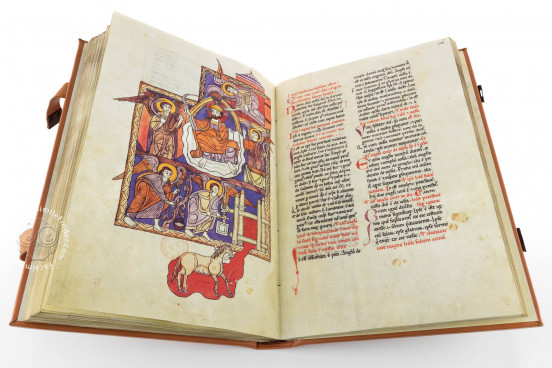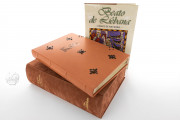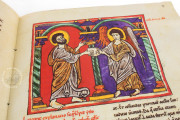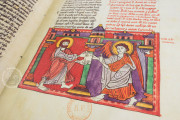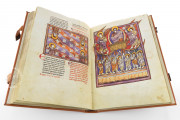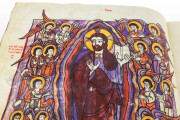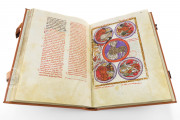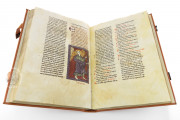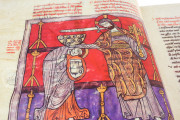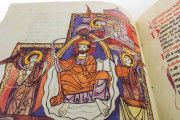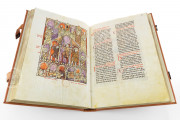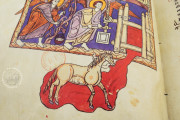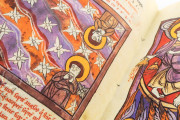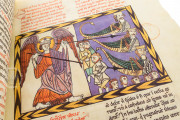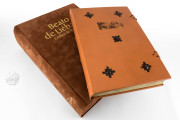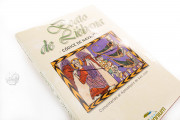The Navarra Codex is a late twelfth-century illuminated manuscript, likely produced in the kingdom of León. It contains Beatus of Liébana's commentary on the Christian biblical book of the Apocalypse. With nearly sixty miniatures, including a mappa mundi, the manuscript is a prime example of late Romanesque art evolving toward Gothic, combining intense colors, expressive forms, and strong symbolism. Its dramatic images serve a didactic purpose, visually reinforcing the themes of the biblical text.
The term "Beatus" designates a specific category of medieval manuscripts, predominantly of Spanish provenance, containing exegetical commentaries on the Book of Revelation (the Apocalypse of Saint John). These manuscripts derive their name from their original author, Beatus of Liébana, an 8th-century monk whose primary objective was theological instruction and clerical education, although certain manuscripts later served liturgical and ceremonial functions as well.
Beatus of Liébana's Commentary and Its Heritage
Beatus initially composed his commentary in 784 CE, but subsequently revised the text multiple times. Later scribes and theologians continued this editorial tradition, resulting in several distinct recensions of the work. Currently, scholars have identified 27 illuminated manuscripts that conform to the characteristics of Beatus commentaries. These invaluable codices, collectively referred to as the "Beatus of Liébana" manuscripts, are preserved in various prestigious libraries worldwide. Among these, the Navarra Codex represents a later iteration of Beatus's original commentary.
Provenance of the Navarra Codex
The manuscript's provenance can be partially reconstructed through documentary evidence. A colophon dated May 4, 1389, bearing the signature of Charles III of Navarra, confirms royal ownership of the codex during the late 14th century. Another historical record indicates that by 1665, the manuscript had been transferred to the cathedral of Pamplona. The subsequent history of the codex remains obscure until the 19th century, when it was acquired by the Bibliothèque Nationale de France, joining two other significant Beatus manuscripts already in their collection.
The distinguished librarian and scholar Léopold Delisle was particularly impressed by the manuscript's vibrant pigmentation and powerful iconography, which he attributed to the northern Spanish illumination tradition. This acquisition prompted Delisle to undertake the first comprehensive comparative analysis of all known Beatus manuscripts at that time.
Artistic and Codicological Features
The Navarra Codex contains nearly sixty miniatures, including several full-page and double-page illustrations. While the iconographic program derives from North African pictorial traditions, the manuscript displays clear influences of emerging Gothic artistic conventions that penetrated northern Spain during the 12th century, likely transmitted through Cistercian monastic networks and pilgrims traveling the Santiago de Compostela route.
The manuscript's elegant late Carolingian script, accompanied by chromatic and decorated initials, complements the illuminations. Together, these elements effectively fulfill the manuscript's primary function: conveying the eschatological message of the Apocalypse with profound visual and textual impact.
For more information on the Beatus model, read our blog article by Amy R. Miller (PhD, Medieval Art History, University of Toronto).
We have 1 facsimile edition of the manuscript "Beatus of Liébana - Navarra Codex": Beato de Liébana, códice de Navarra facsimile edition, published by Millennium Liber, 2007
Request Info / Price
